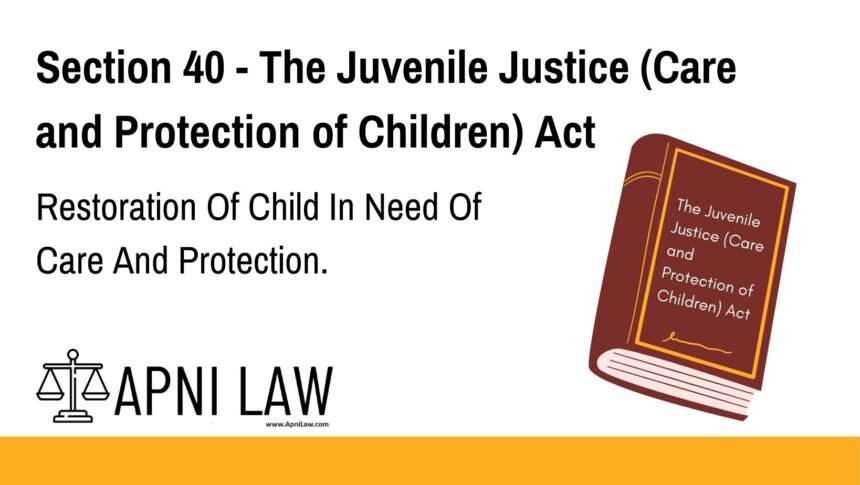Code
(1) The restoration and protection of a child shall be the prime objective of any Children’s Home, Specialised Adoption Agency or open shelter.
(2) The Children’s Home, Specialised Adoption Agency or an open shelter, as the case may be, shall take such steps as are considered necessary for the restoration and protection of a child deprived of his family environment temporarily or permanently where such child is under their care and protection.
(3) The Committee shall have the powers to restore any child in need of care and protection to his parents, guardian or fit person, as the case may be, after determining the suitability of the parents or guardian or fit person to take care of the child, and give them suitable directions.
Explanation.—For the purposes of this section, restoration and protection of a child means restoration to—
(a) parents;
(b) adoptive parents;
(c) foster parents;
(d) guardian; or
(e) fit person.
(4) The Committee shall submit a quarterly report regarding restored, dead and runaway children to the State Government and the District Magistrate in such form as may be prescribed.
Explanation
Section 40 of the Juvenile Justice Act emphasizes that the foremost goal of institutions like Children’s Homes, Specialized Adoption Agencies, and open shelters is the restoration and protection of children who have been separated from their families. The law mandates that children should be reunited with their biological, adoptive, foster, or guardian families whenever possible and appropriate.
The Juvenile Justice Committee is given authoritative powers to assess the suitability of the person or family the child is to be restored to. Additionally, the Committee is required to maintain transparency and accountability by submitting quarterly reports to the relevant authorities.
Key Highlights
-
Restoration is the primary goal—either to parents, adoptive/foster parents, guardians, or fit persons.
-
Restoration must be based on careful evaluation of suitability.
-
Quarterly reports on restored, deceased, and runaway children are mandatory.
-
Institutions are responsible for both care and proactive efforts to reintegrate children.
Illustrations
Example 1: A child who is temporarily placed in an open shelter due to parental separation is restored to her father once the home environment is assessed as safe and nurturing.
Example 2: A baby abandoned at birth and taken into a Specialized Adoption Agency is later adopted by a vetted couple. This is considered restoration under clause (a) and (b).
Example 3: At the end of every quarter, the Child Welfare Committee (CWC) of a district submits a report to the District Magistrate listing the number of children restored to families, those who left institutional care, and any reported runaways or deaths.
Common Questions and Answers
Q1: What does “restoration” mean under Section 40?
A: Restoration refers to placing the child back with parents, adoptive or foster parents, guardian, or any fit person as deemed appropriate by the Committee.
Q2: Who decides if a child can be restored to a family?
A: The Juvenile Justice Committee evaluates the suitability of the proposed guardian or family and makes the final decision.
Q3: Can children be placed back with families if the separation was due to abuse or neglect?
A: Only after a thorough assessment. If the environment remains unsafe, restoration will not be permitted.
Q4: What are “fit persons” under the Act?
A: Individuals or entities considered capable by the Committee to provide care, protection, and a safe environment for the child.
Q5: Is there oversight on the restoration process?
A: Yes. The Committee must submit quarterly reports to the State Government and District Magistrate to ensure transparency and follow-up.
Conclusion
Section 40 underlines the importance of family-based care and the role of state institutions in ensuring that children are not kept in institutional care longer than necessary. It creates a framework where child welfare bodies actively work to reunite children with their families or suitable guardians, while also maintaining oversight through mandated reporting.
🔗 For more on child welfare procedures, visit ApniLaw – Bare Acts and Legal Guides.








